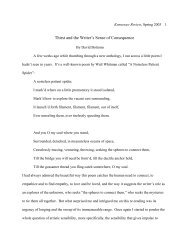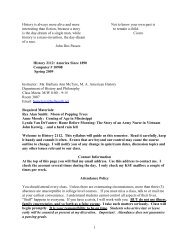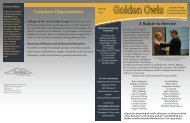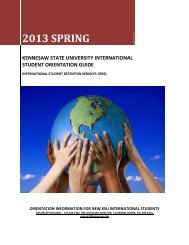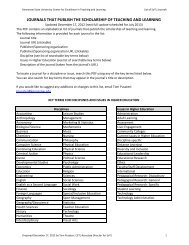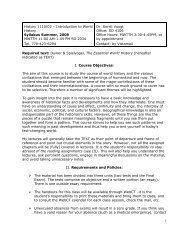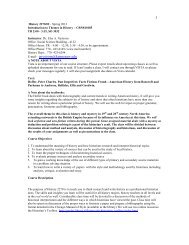Food, Gender and Cultural Hegemony - Kennesaw State University
Food, Gender and Cultural Hegemony - Kennesaw State University
Food, Gender and Cultural Hegemony - Kennesaw State University
Create successful ePaper yourself
Turn your PDF publications into a flip-book with our unique Google optimized e-Paper software.
Cualli 131<br />
many foods. Before corn became the basis for the common meal <strong>and</strong> the tortilla it was<br />
already the basis for chicha (the sacred maize beer in the Chavin culture). Corn was<br />
also a crop that required intensive labor, both in cultivation <strong>and</strong> in processing.<br />
Women were intimately associated with the enormous labor of grinding the corn <strong>and</strong><br />
producing tortillas <strong>and</strong> tamales. A good housewife was defined as a woman who fed<br />
her family well. Newborn girls were told at birth: “Thou wilt become fatigued, thou<br />
wilt become tired; thou art to provide water, to grind maize, to drudge,” (Sahagun<br />
6:172; 10:12). Another indication of the high symbolic importance of maize is that<br />
corn ears are often found in burial mounds (Hastorf <strong>and</strong> Johannessen 427-443; Coe 9;<br />
Soustelle 145).<br />
Bread made from wheat had a similar level of cultural salience in Europe.<br />
Bread <strong>and</strong> wheat also had that dimension of versatility or ambiguity that came to<br />
signify sufficiency or prosperity. It stood for the idea of the just price <strong>and</strong> its<br />
availability was seen as a basis for the moral economy (Magagna 66). Europeans<br />
expected that bread would be available for a good diet, even that it should be an<br />
entitlement, <strong>and</strong> if it was not made available by those responsible for the bread supply,<br />
there could be protests <strong>and</strong> even food riots. Also, similar to corn, bread was the basis<br />
of sacred power. After the Fourth Lateran Council in 1215, the official doctrine of<br />
transubstantiation determined that during the Latin Mass “the substance of the bread is<br />
transformed into the actual body of Christ,” (Albala 2). For Victor Magagna this<br />
cultural dimension was intimately related to the fact that wheat was a cereal-based<br />
food culture ubiquitous in Europe that also required milling <strong>and</strong> processing. This<br />
labor dimension then gave the producing household substantial rights in the chain of<br />
food production <strong>and</strong> distribution. The government was seen as responsible to fulfill<br />
the moral (indeed sacred) obligation to provide the people with bread.<br />
Jack Goody emphasizes the relationship of food <strong>and</strong> cooking to “the<br />
distribution of power <strong>and</strong> authority in the economic sphere, that is, to the system of<br />
class or stratification <strong>and</strong> to its political ramifications,” (Goody 37). This idea brings<br />
us to the relationship of food to power for the societies involved in the conquest. The<br />
Spanish crown was intensely aware of its moral obligation to provision the Spanish<br />
colonists in the New World. This was extremely obvious in the early years when<br />
[Type text]



